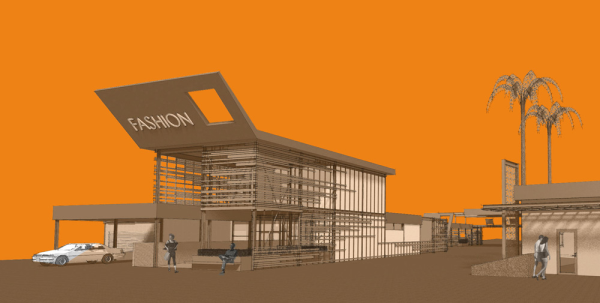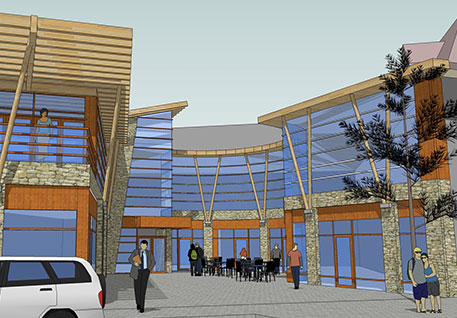Discover the Innovative Solutions Used by Commercial Architects for Your Next Project
Commercial architects play a necessary role fit the developed setting. They mix functionality with aesthetic allure, creating areas that reverberate with brand name identity. These experts employ ingenious design options, lasting methods, and progressed modern technologies to enhance user experiences. Their collective technique warranties alignment with customer visions and functional demands. The level of their solutions typically expands past layout. The following steps in understanding just how these architects navigate complex project demands may surprise you.
Understanding the Role of Commercial Architects
The duty of industrial architects may vary depending on the particular project, their key feature revolves around developing functional and cosmetically enticing areas for companies. These professionals are tasked with recognizing the special requirements of each client, whether it be a retailer, office structure, or commercial facility. They carry out detailed website analyses and team up with stakeholders to assure that the layout lines up with business objectives and brand identity.Commercial architects additionally navigate various governing requirements, safeguarding conformity with zoning laws and building regulations. Their experience encompasses developing lasting styles that promote energy performance and ecological duty. Furthermore, they manage the task's timeline and spending plan, coordinating with professionals and designers throughout the building procedure. By blending creative thinking with technical expertise, commercial architects play a crucial duty in transforming theoretical ideas right into tangible truths, ultimately improving the functionality and charm of commercial rooms.
Ingenious Design Solutions for Special Spaces
As industrial rooms progressively require distinctiveness to attract attention in competitive markets, ingenious layout options have come to be necessary for architects. These professionals take advantage of their creativity and technical experience to craft unique atmospheres that show brand name identification and boost customer experience. By incorporating sophisticated modern technology and materials, commercial architects can change normal areas into captivating places that involve consumers and motivate employees.Architects employ various techniques, such as adaptive reuse, which rejuvenates existing structures while protecting their historic significance. They also explore non-traditional designs and multifunctional areas that provide to diverse needs, making sure versatility for future growth.Furthermore, the consolidation of biophilic style-- bringing nature indoors-- creates welcoming ambiences that advertise wellness - commercial architects. This focus to detail in innovative design not only addresses aesthetic problems yet additionally promotes neighborhood and collaboration. Ultimately, these customized options enable companies to prosper in an ever-evolving landscape, establishing them in addition to rivals
Sustainable Architecture Practices
Lasting design practices have actually become a critical emphasis for commercial architects seeking to create impactful layouts that reverberate with environmental stewardship. These practices focus on the usage of renewable energies, power performance, and marginal waste, showing a commitment to reducing the eco-friendly impact of buildings. Architects integrate materials that are sustainably sourced or reused, guaranteeing that building and construction techniques align with environmental principles.Furthermore, the integration of environment-friendly roofing systems and wall surfaces enhances biodiversity while boosting energy performance. Reliable water administration systems, such as rain harvesting, add to sustainability by preserving water resources. All-natural ventilation and daylighting methods are also utilized to maximize indoor atmospheres, reducing dependence on artificial heating and lights.
Integrating Technology in Architectural Styles
A boosting variety of industrial architects are welcoming technology as a transformative component in building style. By leveraging advanced software program devices such as Building Details Modeling (BIM), architects can create in-depth 3D depictions of projects, permitting enhanced visualization and partnership amongst stakeholders. This modern technology helps with real-time modifications, lessening mistakes and enhancing the layout process.Additionally, architects are incorporating smart building innovations into their designs, which improve energy efficiency and resident convenience. Attributes such as automated illumination, environment control, and safety and security systems can be flawlessly incorporated, promoting lasting techniques and decreasing operational costs.The use of online and enhanced reality also allows clients to experience designs prior to construction begins, supplying important insights into spatial relationships and visual selections. Inevitably, the combination of innovation in architectural styles not only fosters innovation yet additionally ensures that projects are executed with accuracy and straightened with contemporary demands.

Project Administration and Coordination Solutions
Reliable job monitoring and coordination solutions are vital for the successful execution of business building tasks. These solutions ensure that all elements of a task, from first layout to final building, are effortlessly incorporated. Commercial architects play a substantial role in working with in between numerous stakeholders, including clients, service providers, and providers, to preserve clear interaction and alignment on project goals.By carrying out organized methodologies, architects can manage timelines, budgets, and sources effectively, reducing delays and expense overruns. They make use of task management software and tools to track development, handle paperwork, and help with collaboration amongst group members.Additionally, these services include danger analysis and mitigation techniques, validating potential challenges are determined and resolved proactively. The outcome is a structured procedure that boosts total task performance and high quality, eventually causing an effective result that satisfies the client's vision and assumptions.
Regulative Conformity and Zoning Support
Reliable regulatory conformity and zoning assistance are necessary for the success of any kind of commercial project. Architects need to possess a deep understanding of neighborhood policies and zoning legislations to lead customers with the intricacies of the authorization process. This expertise not only guarantees adherence to lawful needs yet likewise helps optimize task style and functionality.
Navigating Local Regulations
Exactly how can industrial architects guarantee their layouts straighten with regional policies? By staying educated regarding the ever-evolving landscape of building codes and regional statutes, architects play a necessary role in making certain compliance. They perform extensive research study to comprehend the details regulations governing products, security criteria, and building methods suitable per project. Working together very closely with local authorities, industrial architects can steer via the complexities of regulative structures efficiently. They likewise promote essential permits and inspections, simplifying the approval process. This positive technique not just minimizes potential legal problems however likewise boosts project efficiency. Ultimately, their experience in maneuvering local policies empowers clients to realize their vision while adhering to all required standards and guidelines.
Zoning Regulation Knowledge
Zoning legislation expertise is necessary for business architects steering through the complexities of land usage laws. These architects have comprehensive knowledge of local zoning codes, which govern residential property growth, land usage, and building specifications. By you can try here understanding these regulations, they aid customers navigate the typically detailed approval procedures needed for building jobs. Their knowledge guarantees conformity with zoning legislations, reducing the risk of task hold-ups or legal complications.Additionally, industrial architects offer beneficial help in getting essential authorizations and differences, facilitating smoother communications with neighborhood authorities. They additionally use critical suggestions to enhance site layout and take full advantage of the capacity of a residential property while sticking to zoning limitations. Ultimately, their zoning regulation proficiency plays a crucial role in the effective awareness of business projects.
Joint Methods With Customers and Stakeholders
Successful business architecture rests on the ability to promote strong partnership with customers and stakeholders throughout the style procedure - commercial architects. Architects take part in open discussions, making sure that all events' visions and needs are incorporated into the task. This collaborative approach begins in the first phases, where architects carry out workshops and brainstorming sessions, permitting customers to verbalize their objectives and concerns.Stakeholder input is equally crucial; architects typically organize conferences with neighborhood participants, city governments, and other pertinent entities to gather varied point of views. By using visualization tools, such as 3D modeling, architects promote better understanding and communication.This iterative comments procedure not just improves style top quality yet also builds depend on, leading to more successful outcomes. Ultimately, the collaborative approach of industrial architects changes concepts into useful spaces that reflect the goals of clients and the more comprehensive area, ensuring a harmonious relationship throughout the project lifecycle

Regularly Asked Inquiries
What Is the Normal Timeline for a Commercial Design Project?
The find out regular timeline for a commercial architecture project differs, usually extending 6 to 18 months. Variables affecting this duration include project complexity, regulatory authorizations, and customer responsiveness, affecting each phase from design to building and construction conclusion.
Just How Do Commercial Architects Fee for Their Solutions?
Commercial architects usually charge based on task extent, intricacy, and size. Typical charge structures consist of per hour rates, repaired fees, or percentage-based costs determined from the overall construction price, making sure transparency and alignment with customer assumptions.
Can Commercial Architects Aid With Interior Decoration?
Commercial architects can indeed aid with interior style, incorporating capability and appearances. Their know-how guarantees cohesive areas that straighten with architectural vision, improving user experience while satisfying governing needs and client goals with cutting-edge layout solutions.
What Sorts of Clients Do Commercial Architects Commonly Collaborate With?
Commercial architects generally work together with diverse customers, consisting of organizations, federal government entities, universities, and non-profit companies (commercial architects). Each client looks you can try this out for customized architectural options to meet certain useful and visual demands for their tasks and environments
Exactly How Do Commercial Architects Keep Updated With Style Fads?
Commercial architects stay upgraded with style patterns through continuous education, attending industry meetings, participating in expert networks, and investigating emerging technologies. They also collaborate with other experts to acquire insights into innovative materials and design techniques.